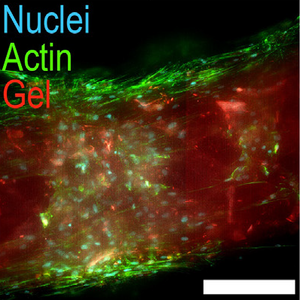
Hydrogels can be used as a 3D scaffold for cells to grow in tissue models and biofabrication applications. Such hydrogels can be made from proteins that form amyloid fibrils. Different biological applications have distinct requirements for the properties of these hydrogels. Designing a unique biopolymer for each application is cumbersome and to be able to assemble tailored systems from a set of predefined building blocks is beneficial.
In a study, published in Acta Biomaterialia, researchers from ETH Zurich in Switzerland present an approach for a modular protein hydrogel platform. Their system allows the differentiation of hMSCs into osteoblasts, and the growth of neurite networks from primary neurons. In addition, their hydrogel system is compatible with 3D-printing of complex scaffolds. Self-assembly of these hydrogels from recombinant proteins happens within 1 h at a temperature of 60 °C.
Using Amytracker, the authors confirmed the assembly of the hydrogel from amyloid fibrils. They produced hydrogels from two types of building blocks (block A and block B). Block A is designed to form the amyloid fibrils and to facilitate the assembly of the polymer into a hydrogel. Block B contains bioactive amino acid motifs that can be modified if necessary. In this study RGD cell-attachment motifs were the motifs of choice. Block B at the same time acts as a flexible linker by connecting blocks A. The packing pattern and hardness of the hydrogel can be adjusted by varying the molar ratio between blocks A and B and by changing the length of block B.
